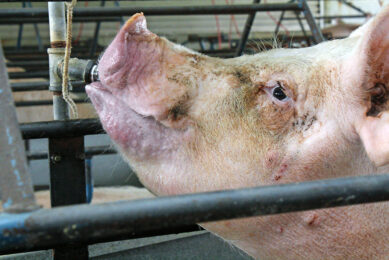USDA: How they resolved dozens of agri- export issues

Agriculture Secretary Tom Vilsack highlighted recently how the US Department of Agriculture (USDA) resolved dozens of export issues in 2012, freeing up an estimated US$4 billion in US agricultural and forestry exports and protecting roughly 30,000 American jobs in the process. The work is highlighted on Performance.gov.
“As consumers around the world demand high-quality, American-grown products, USDA staff are monitoring more than 160 markets to ensure an open system of trade, free from unwarranted and unjustified barriers,” said Vilsack. “Since 2009, USDA has acted to remove hundreds of unfair barriers to trade for American companies and is providing businesses with the resources they need to reach new markets. These efforts have resulted in the most successful period in the history for American agriculture and a boon for America’s rural economies and agriculture-related businesses.”
Over the past year, USDA has aggressively worked to eliminate barriers, open new markets, secure the release of US shipments detained at foreign ports, and ensure the safe movement of agricultural products in a manner consistent with science and international standards. Overall, a highly-dedicated group of USDA Foreign Service officers, animal and plant health experts, and analysts monitor 162 markets around the world, ensuring a level playing field for US businesses and products. USDA works in partnership with the Office of the US Trade Representative (USTR) and other federal offices and agencies.
Currently, the American brand of agriculture is surging in popularity worldwide, while US agricultural exports support more than 1 million jobs in communities across the country. Fiscal years 2009 through 2012 generated more than US$478 billion in agricultural exports, and 2013 agricultural exports remain on track to set new records. Overall, America’s agricultural sector is playing a key role in helping to achieve President Obama’s goal under the National Export Initiative of doubling exports by the end of 2014.
This success builds on USDA’s efforts to break down barriers to trade and expand access for US goods around the world. Earlier this week, USDA announced that the Government of Japan—the fourth largest agricultural export market for the United States—agreed to expand access for U.S. beef. Under these new terms, which enter into effect on February 1, 2013, Japan will now permit the import of beef from cattle less than 30 months of age, compared to the previous limit of 20 months, among other steps. It is estimated that these important changes will result in hundreds of millions of dollars in exports of U.S. beef to Japan in the coming years. This agreement also goes a long way toward normalizing trade with Japan by addressing long-standing restrictions that Japan introduced in response to bovine spongiform encephalopathy (BSE).
As American businesses look to reach the 95% of consumers outside of US borders, USDA is providing support and service. For example, in 2012, USDA has been able to help conduct more than 110 trade shows around the world to help more than 1,000 US companies make more than US$500 million in on-site sales. The majority of these were small and medium-sized businesses. While strong exports benefit farms and rural communities, agricultural trade is also a building block for a strong national economy.
Along with their federal partners, USDA’s Animal and Plant Health Inspection Service (APHIS) works to protect the health and value of American agriculture and natural resources in the international environment. Last year, APHIS successfully negotiated and resolved 150 animal and plant health issues involving US agricultural exports. Examples include:
- Spearheaded a six month pilot programme with China’s animal and plant health authority which established the resumption of log exports from Virginia and South Carolina, resulting in more than US$1.5 million in US hardwood log exports to China from those States. The pilot programme was recently extended by China. The pilot programme signals renewed Chinese confidence in Virginia and South Carolina forestry exports. The United States exported more than US$7.7 billion in forestry products in 2011, supporting more than 65,000 jobs. During the first eleven months of 2012, US log exports to China from all states reached nearly $730 million. Nearly 25 percent of those exports landed in China, the second largest market for US timber. Seaports in Virginia and South Carolina handled more than half-a-billion-dollars in US forestry exports in 2011.
- Worked with Mexican officials to spur US table eggs exports to Mexico valued at US$45 million per year.
- Secured Japanese market access for poultry and poultry products from New York, Ohio and South Dakota. In 2011, US poultry exports to Japan totalled US$88 million.
- Secured the release of 324 shipments of US agricultural products detained at foreign ports, valued at more than US$41 million. For example, APHIS recently secured the release of seven grain shipments valued at $1.8 million from the port of Haiphong, Vietnam, and the agency continues to work with Vietnamese officials and the US grain industry on a permanent solution that will keep exports moving efficiently to that market.
The Obama Administration, with Agriculture Secretary Vilsack’s leadership, has aggressively worked to expand export opportunities and reduce barriers to trade, helping to push agricultural exports to record levels. US agriculture is currently experiencing its best period in history thanks to the productivity, resiliency, and resourcefulness of our producers and agribusinesses. Today, net farm income is at record levels while debt has been cut in half since the 1980s. Overall, American agriculture supports 1 in 12 jobs in the United States and provides American consumers with 83% of the food we consume, while maintaining affordability and choice. Strong agricultural exports contribute to a positive US trade balance, create jobs, boost economic growth and support President Obama’s National Export Initiative goal of doubling all US exports by the end of 2014. Read further on the USDA website.
Join 18,000+ subscribers
Subscribe to our newsletter to stay updated about all the need-to-know content in the pigsector, three times a week. Beheer
Beheer










 WP Admin
WP Admin  Bewerk bericht
Bewerk bericht